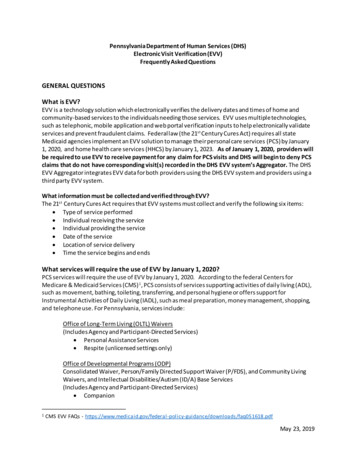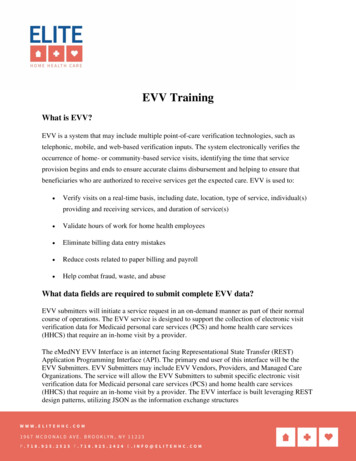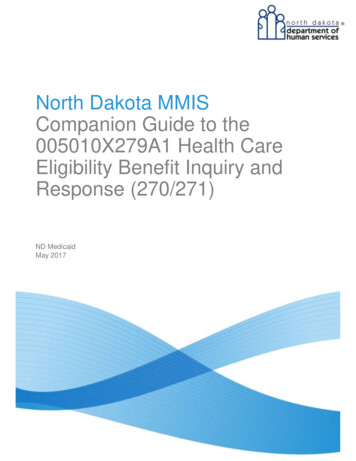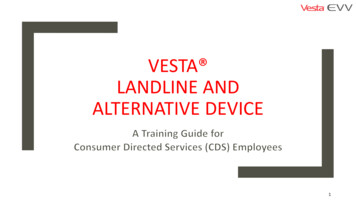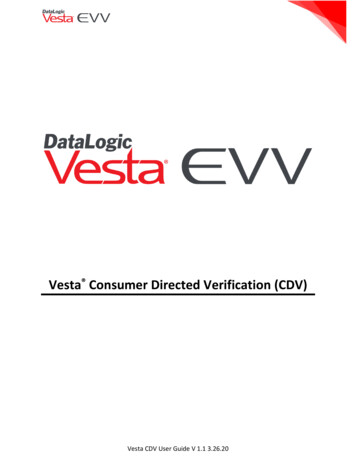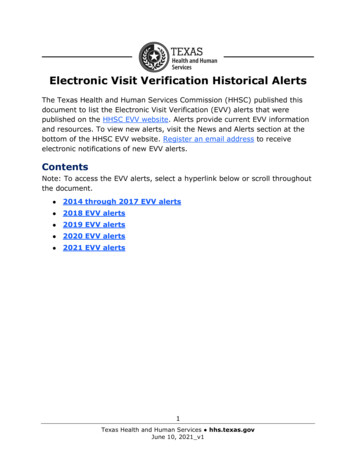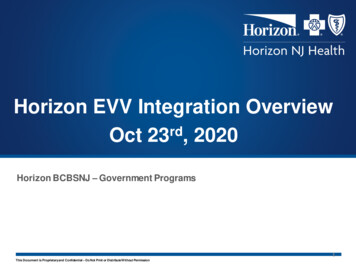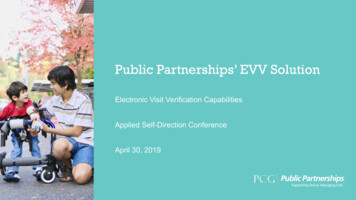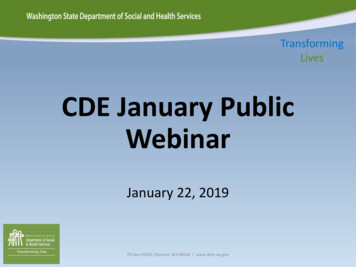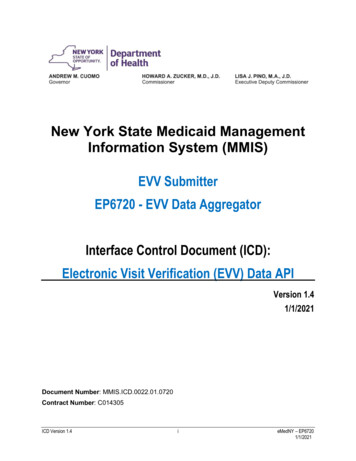
Transcription
:TEOFORTUNITY.Departmentof HealthANDREW M. CUOMOGovernorHOWARD A. ZUCKER, M.D., J.D.CommissionerLISA J. PINO, M.A., J.D.Executive Deputy Comm issionerNew York State Medicaid ManagementInformation System (MMIS)EVV SubmitterEP6720 - EVV Data AggregatorInterface Control Document (ICD):Electronic Visit Verification (EVV) Data APIVersion 1.41/1/2021Document Number: MMIS.ICD.0022.01.0720Contract Number: C014305ICD Version 1.4ieMedNY – EP67201/1/2021
Table of ContentsTable of ContentsTable of Contents.iiList of Figures .iiiList of Tables.iii1. Purpose of Interface Control.12. Introduction.23. Overview.34. Assumptions/Constraints/Risks .44.1 Assumptions .44.2 Constraints.44.3 Risks .45. General Interface Requirements .55.1 Interface Overview .55.2 Functional Allocation .55.3 Data Transfer .65.4 Transactions .65.5 Security and Integrity.85.6 Operational Support & Service Levels.85.6.1Service Level Agreements (SLA) .85.6.2Operational Expectations.86. Detailed Interface Requirements .96.1 Requirements for Electronic Visit Verification (EVV) Data API.96.1.1General Processing Steps .96.1.2Interface Processing Time Requirements .106.1.3File Naming Convention.106.1.4Message Format (or Record Layout) and Required Protocols.106.1.5Communication Methods .196.1.6Security Requirements.197. Qualification Methods.20Appendix A – Record of Changes.21Appendix B – Acronyms.22Appendix C – Glossary.23Appendix D – Referenced Documents.24Appendix E – Approvals.25Appendix F – Contact Information.26Appendix G – Additional Appendices .27ICD Version 1.4iieMedNY – EP67201/1/2021
List of FiguresList of FiguresFigure 1 – Data Transfer Diagram .6List of TablesTable 1 – EVV Request Data Model Table .12Table 2 – Error Data Model Table .17Table 3 – Error Data Model Table (Provider Attestation) .17Table 4 HTTP Response Status Code to Data Type Mapping Table .18Table 5 – Record of Changes .21Table 6 – Acronyms .22Table 7 – Glossary.23Table 8 – Referenced Documents.24Table 9 – Approvals .25Table 10 – Contact Information .26ICD Version 1.4iiieMedNY – EP67201/1/2021
Purpose of Interface Control1.Purpose of Interface ControlThe Electronic Medicaid of New York (eMedNY) Project Interface Control Document (ICD)defines the eMedNY system’s Electronic Visit Verification (EVV) interface with EVV Submitters.EVV Submitters are entities that will use the interface described in this document to shareinformation on electronically verified in-home visits on behalf of a New York State Medicaidprovider, and may consist of EVV Vendors, Providers, and Managed Care Organizations(MCO). The ICD communicates all inputs and outputs from eMedNY for all potential actions. Itsintended audience is project managers, project teams, development teams, and stakeholdersinterested in submitting data to eMedNY using this interface.ICD Version 1.41eMedNY – EP67201/1/2021
Introduction2.IntroductioneMedNY is the New York State (NYS) Medicaid program claims processing system. The systemallows NYS Medicaid providers to submit claims and receive payments for Medicaid-coveredservices provided to eligible clients.This Interface Control Document (ICD) describes the relationship between eMedNY and EVVSubmitters and specifies the requirements of both participating systems. This includes theconcept of operations, the file structure and protocols that govern the interchange of data, andthe communication paths along which the data is expected to flow.Version 1.4 of this ICD that is published on the eMedNY website is the current and officialversion of the interface. Other versions in development represent proposed changes until fullyapproved.In this document, the following information will be provided: A general description of the interface Assumptions where appropriate A description of the data exchange format and protocol for exchange Estimated size and frequency of data exchangeICD Version 1.42eMedNY – EP67201/1/2021
Overview3.OverviewThe EVV interface will enable providers to easily and securely transmit EVV data to eMedNYwhich will be sent to the Medicaid Data Warehouse (MDW) for analysis. Collecting andaggregating this EVV data is a necessary step for New York state to achieve compliance withthe 21st Century Cures Act (the Cures Act) and avoid Federal Medical Assistance Percentages(FMAP) penalties. Ultimately, the data stored will be mapped to claims and encounters whichwill provide new fraud, waste, and abuse detection capabilities.ICD Version 1.43eMedNY – EP67201/1/2021
ints/Risks4.1Assumptions 4.24.3NoneConstraints eMedNY’s web service is Internet facing. No coding changes that interrupts connectivity between the two systems may beperformed on this interface without NYSDOH approval. All web service request/response activity must be logged, correlated and reviewed toensure compliance with New York State (NYS) auditing practices. ICD will be reviewed and updated based on enhancements or maintenance activitiesand will be posted to the eMedNY website.Risks ICD Version 1.4None4eMedNY – EP67201/1/2021
General Interface Requirements5.General Interface Requirements5.1Interface OverviewThe eMedNY EVV Interface is an internet facing Representational State Transfer (REST)Application Programming Interface (API). The primary end user of this interface will be the EVVSubmitters. EVV Submitters may include EVV Vendors, Providers, and Managed CareOrganizations. The service will allow the EVV Submitters to submit specific electronic visitverification data for Medicaid personal care services (PCS) and home health care services(HHCS) that require an in-home visit by a provider.The EVV interface is built leveraging REST design patterns, utilizing JSON as the informationexchange structures.5.2Functional AllocationEVV submitters will initiate a service request in an on-demand manner as part of their normalcourse of operations. The EVV service is designed to support the collection of electronic visitverification data for Medicaid personal care services (PCS) and home health care services(HHCS) that require an in-home visit by a provider.ICD Version 1.45eMedNY – EP67201/1/2021
General Interface Requirements5.3Data TransferEVV Submitters will initiate a service request over a secure Hyper Text Transfer Protocol(HTTPS) connection to an eMedNY hosted RESTful API. All information will be transferredbetween both the parties as JSON documents or HTTP Uniform Resource Identifiers (URIs)using REST Design best practices.EVVMicro Service BackendHttpsAPI KeySecure API GatewayeMedNYFigure 1 – Data Transfer Diagram5.4TransactionsThe eMedNY EVV Service exposes a single REST HTTPS endpoint for EVV Submitters to sendmember specific details for Medicaid personal care services (PCS) and home health careservices (HHCS) that require an in-home visit by a provider.If the EVV Data (service payload) do not pass validation, the records will be rejected withappropriate reason code. Rejected records should be reviewed for accuracy by the EVVSubmitter. Corrected EVV records can be resubmitted via batch or individual submissionmethod. Submitters will be able to submit multiple EVV records per submission.An EVV Submitter acting as an EVV proxy (Managed Care Organization, VerificationOrganization, Aggregator, Vendor, etc.) will be able to submit for multiple providerswhich can include multiple EVV records per provider per submission.Error handling will be able to accept successful rows and reject only bad rows (with anappropriate reject reason).The service will identify previously accepted records and reject duplicated data with anappropriate reject reason.ICD Version 1.46eMedNY – EP67201/1/2021
General Interface RequirementsUse CaseHTTPURI ]This can beused forsubmittingone or /evv/{transactionId}visiterror[]Can beused forsubmittingonly vv/{transactionId}visiterror[]Can also beused forupdating thetransactionNote:Updates toa previouslyacceptedtransactionwilloverwritethe previousrecord andmay besubject itterId}/evv/{transactionId}visiterror[]This can beused todelete evv/{transactionId}visiterror[]This can beused toretrieve atransactionICD Version 1.47eMedNY – EP67201/1/2021
General Interface Requirements5.5Security and IntegrityThe EVV interface will contain both Protected Health Information (PHI) and PersonallyIdentifiable Information (PII). The security approach for this interface will fall into two areas ofconcern: encryption, and authentication and authorization.The EVV Service will utilize HTTPS with Security Socket Layer (SSL) encryption and theTransport Layer Security (TLS) version 1.2.The EVV Service will leverage API Key for authentication and authorization to enforce identityverification and service authorization. The provider will be able to obtain the API Key from theAPI Developer Portal (Accessed using the eMedNY Web Portal ID and password).Security and data Validation checks will be performed on the EVV web service requests in thisinterface. When issues with this interface are discovered that prevent data exchange, EVVSubmitters will be notified immediately by eMedNY operations team.5.6Operational Support & Service LevelsThis section discusses the Operational Level expectations of the interface regarding availability,performance, and scale. Interfaces do not inherit eMedNY’s “continuously available” SLA’sunless specifically mentioned in the section below.5.6.1Service Level Agreements (SLA)This interface does not have any Service Level Agreements.5.6.2Operational ExpectationsUsage Policy5.6.2.1This interface is designed to meet the use cases as mentioned in the sections above. Extendingthe usage of interfaces beyond the original intent requires the approval of NYSDOH and GDIT.The interface user/consumer might be disabled if their usage pattern presents security risks oroperational expectations are not met.Availability & Performance5.6.2.2Below is the general guidance on the operational levels on this SLA. These are delivered on abest efforts basis. 99.98 with the exception of planned outages Average response is 10 seconds/transaction excluding bulk record submission Maximum number of concurrent connections/API client is 5; more than 5 concurrentthreads will be throttledSupport5.6.2.3 ICD Version 1.4If you face issues with the interface in the production or non productionenvironments, contact the eMedNY Call Center at (800) 343-9000.8eMedNY – EP67201/1/2021
Detailed Interface Requirements6.Detailed Interface RequirementsThis section refers and/or describes details for the EVV interface. This ICD defines theconditions under which the EVV interface is to be leveraged.6.1Requirements for Electronic Visit Verification (EVV) Data APIThe EVV interface supports the need for EVV Submitters to submit Electronic Visit Verificationdata for Medicaid personal care services (PCS) and home health care services (HHCS) thatrequire an in-home visit by a provider.The eMedNY program exposes the EVV service for the sole purpose of meeting the New YorkState Department of Health (DOH) requirement under the 21st Century Cures Act (the CuresAct), mandating that states implement Electronic Visit Verification (EVV) for all Medicaidpersonal care services (PCS) and home health care services (HHCS) that require an in-homevisit by a provider. The API consumers (EVV Submitters) and API provider (eMedNY API Platform) areexpected to adhere to REST best practices in API access and operations.REST Enabled Client with the ability to consume and produce Content-Type:application/jsonAPI Consumers should be able to produce JSON payloads that meet the servicespecification (Refer to Open API Specification document).API Consumers should accurately use the appropriate URI patterns recommended foreach transaction along with HTTP verb.If you are already enrolled in eMedNY, you may sign up for an eMedNY Web Portal account athttps://portal.emedny.orgYour eMedNY Web Portal account credentials can be used to access the following eMedNY APIDeveloper Portal:Production API Developer Portal: https://developer.emedny.ioTest API Developer Portal: https://developer.emednytest.ioThe following URL’s will be used as the base URI for the eMedNY EVV web service forproduction and test environments:Production: https://api.emedny.ioTest: https://api.emednytest.io6.1.1General Processing StepsEVV Submitters can invoke the EVV service as needed to submit electronic visit verificationdata for Medicaid personal care services (PCS) and home health care services (HHCS) thatrequire an in-home visit by a provider.ICD Version 1.49eMedNY – EP67201/1/2021
Detailed Interface Requirements6.1.2Interface Processing Time RequirementsElectronic Visit Verification (EVV) Data API offers services on a “Best Effort” basis. There is noguarantee on availability or performance but every reasonable effort would be taken to provide ahighly available and responsive service.On average service is expected to respond within 10 seconds excluding bulk record submission.A maximum on 5 concurrent calls/second is allowed / consumer. API Access will be revoked ortemporarily denied if service policies are violated.6.1.3File Naming ConventionN/A6.1.4Message Format (or Record Layout) and Required ProtocolsAPI Message format is documented and managed through an Open API Specification andmethod to model and document REST API. Message interchange format is JSON. Both inboundand outbound message format should comply with the object model provided in the Open APISpecification document. See Appendix G.HTTP Protocol6.1.4.1The Electronic Visit Verification (EVV) Data service will expose its endpoints over secure HTTP(HTTPS). The service will leverage HTTP status codes to inform the consumer of the responsebeing returned.At no point will the service be executed by EVV Submitters over an insecure protocol.6.1.4.1.1HTTP Response Status CodesThe Electronic Visit Verification (EVV) Data API adheres to REST design principles in that theservice will return an HTTP response status code which provides clients of their request’soverarching result. At a high level the following series of status codes can be categorized asfollows:-2xx: Success – Indicates that the client’s request was accepted successfully4xx: Client Error – Indicates that the client must take some additional action in order tocomplete their request.5xx: Server Error – Indicates that the server takes responsibility for these error statuscodesGenerally speaking, client error codes in the 4xx range are a result of an error on the client sideand will require that the client, in this case EVV Submitters, take an action to resolve thereturned error. Whereas 5xx range status codes require that the service, in this case eMedNY,must take an action to resolve the error.The following are the HTTP Response Status Codes which will be returned by the service andtheir associated meaning. With each Response Status Code, a specific response data structurewill be returned, data structures will be addressed in the next section of this document.6.1.4.1.1.1HTTP STATUSCODE200ICD Version 1.4Summary of HTTP Response Status CodesSuccessDESCRIPTIONEXAMPLE SCENARIOSOKStandard response for successful HTTP requests.10eMedNY – EP67201/1/2021
Detailed Interface Requirements201Created204No Content206Partial Content400Client ErrorBad Request401Unauthorized403Forbidden404Not Found5006.1.4.2ServerErrorInternal ServerErrorThe request has been fulfilled and resulted in a newresource being created.The server has successfully fulfilled the request and thatthere is no additional content to send in the responsepayload body.The server is successfully fulfilling a range request for thetarget resource by transferring one or more parts of theselected representation that correspond to the satisfiableranges found in the request’s Range header field.The request cannot be fulfilled due to bad syntax.The message requested did not adhere to the structuredefined inside the Open API Specification.The service has denied your request due to a failure inauthentication.Review your security credentials to ensure they areaccurate.The service has denied your request due to the client nothaving the proper authorization to invoke the service.Unlike a 401, a retry will not resolve the issue. ContacteMedNY operations support to grant permission for theclient to access the service.The requested resource could not be found but may beavailable again in the future. Subsequent requests by theclient are permissible.An error occurred within the application and the applicationcould not process the requests.This error implies an issue with the service and not with theclient or the data which was passed to the service by theclient.This error implies that the request can be tried again oncethe service issues have been resolved.Data Assembly CharacteristicsThe EVV Service defines a single endpoint for consumption. As this service is a REST service,the interface is governed by an Open API Specification. This specification defines the input andoutput behaviors of the service including: endpoint mappings, request data types, and responsedetail like: each http response code and the associated response data type. Attached inAppendix G you will find the Open API Specification which describes the EVV service.The next sections will discuss the details of the request and response data structures.ICD Version 1.411eMedNY – EP67201/1/2021
Detailed Interface RequirementsTable 1 – EVV Request Data Model iredDescription/ValidationVisit nationalProviderIdICD Version 1.4stringstringMin: 1Max: 1508date-onlystringstringYYYY-MM-DDMax: 351012YesUnique transaction ID per visit generatedby the EVV system when the EVV recordis generated. Transaction ID must not begenerated outside the EVV systemincluding during submission.The recommendation would be to use aUUID/GUID Compliant ID if available.YesMedicaid Id for the recipient receiving theservice.A unique identifier assigned to eachMedicaid Member by the WelfareManagement System (WMS) or NYSoH.It serves to identify the medical datapertaining to the individual as the uniquepermanent identifier.Must pass Client ID Check Digit.Client ID must exist on eMedNY.YesDate of Birth of the recipient receiving theservice.Cannot be greater than the current date(future date).Must match the date of birth on eMedNY.NoProvider Name is the name of a providerof Medicaid services as used on officialState records.Provider Name should match the nameused on Medicaid claims and encounters.This represents the name of the BillingProvider.SituationalNational Provider Identifier (NPI) is thenationally recognized provider identifierassigned by the Center for Medicare &Medicaid Services (CMS).eMedNY – EP67201/1/2021
Detailed Interface matRequiredDescription/ValidationThe NPI, if populated, should match whatis on the claim or encounter thatcorresponds to the service.Required if MMIS Identifier is not present.Must Pass NPI Billing Check Digit.When NPI and Provider ID are bothpresent, they must be a valid combinationin eMedNY.This represents the NPI of the sICD Version 1.4stringstring8Situational9YesAddressNo13MMIS Identifier is a unique numbergenerated by the eMedNY system andassigned to each provider enrolled toprovide services to Members of theMedicaid program. This number is theprimary method of identifying a provider.The MMIS ID, if populated, should matchwhat is on the claim or encounter thatcorresponds to the service.Required if National Provider Identifier(NPI) is not present.Must pass MMIS Billing Check Digit.Must be active on Date of Service.When NPI and Provider ID are bothpresent, they must be a valid combinationin eMedNY.This represents the MMIS ID of the BillingProvider.Federal Employer Identification Number(FEIN). This represents the TaxPayer IDof the Billing Provider.Providers most current street address,city, state and zip code.This represents the address of the BillingProvider.eMedNY – EP67201/1/2021
Detailed Interface berLengthFormat4Min: 5Max: 52RequiredDescription/ValidationSituationalRate Code specifies a medical service orproduct that utilizes a rate reimbursementtechnique processed by the eMedNYsystem. All Institutional claims are paid byrate code and they include: Clinic,Managed Care, Inpatient, ICF/DD, ChildCare, Home Health and Nursing Homeclaims.Required if Procedure Code is notpresent.Must be a valid rate code.Applicable billing codes can be found athttps://www.health.ny.gov/health care/medicaid/redesign/evv/repository/app billing codes.htmSituationalProcedure Code for the service renderedto the recipient by the provider.Required if Rate Code is not present.Must be a valid (HCPCS) procedurecode.Applicable billing codes can be found athttps://www.health.ny.gov/health care/medicaid/redesign/evv/repository/app billing codes.htmNoTwo character number modifying theprocedure code for the service renderedto the recipient by the provider.Must be a valid modifier, up to -MMDDThh:mm:ssYesBegin date/time of the service receivedby the recipient.Must be a valid date/time.Cannot be greater than the current date(future date).Timestamp is :ssYesEnd date/time of the service received bythe recipient.Must be a valid date/time.ICD Version 1.414eMedNY – EP67201/1/2021
Detailed Interface matRequiredDescription/ValidationMust be greater than Begin date/time.Cannot be greater than the current date(future date).Timestamp is roviderFirstNamestringMin: 4Max: 9stringMin: 4Max: 9stringMin: 1Max: 35YesService start location describes the placewhere the visit began at the service starttime. (Home, Community)Must be a valid service start location.YesService end location describes the placewhere the visit concluded at the serviceend time. (Home, Community)Must be a valid service end location.YesFirst name of the servicing worker.This should match employment recordsmaintained by the billing provider.This represents the first name of thecaregiver providing the service.YesLast name of the servicing worker.This should match employment recordsmaintained by the billing provider.This represents the last name of thecaregiver providing the service.NoPhone number of the servicing worker.This represents the phone number of thecaregiver providing the service.serviceProviderLastNamestringMin: 1Max: 60serviceProviderPhoneNumberstring10stringMin: 1Max: 128YesThe Caregiver ID is the ID used touniquely identify the person providing theservice within the Provider’s EVV Systemand/or solution.address1stringMax: 40YesBuilding Number or Street Line 1address2stringMax: 40NoBuilding Number or Street Line 2citystringMax: 25YesCitycaregiverId9999999999Address ObjectICD Version 1.415eMedNY – EP67201/1/2021
Detailed Interface testringMax: 2zipstringMin: 5Max:9Format99999 esZip CodeYesThe organization submitting the EVVtransactions on behalf of the Provider.The Submitter ID will be in the URI and isnot required as a payload, since it will besame for a given submitter. This is also inline with the REST Design and allows usto apply security rules based on thesubmitter.Submitter IDsubmitterIdICD Version 1.4string816eMedNY – EP67201/1/2021
Detailed Interface Requirements6.1.4.2.1.1Error Data ModelsIn the event that the EVV service encounters an error the service will respond with an error message. The error message along withthe HTTP Response Status Code will provide EVV Submitters with detail related to the issue encountered.Table 2 – Error Data Model quiredDescriptionA simple message returned from theservice upon encountering an error.ErrortransactionIdYesUnique transaction ID used by the EVVvendor to submit the transaction.codeYesError CodemessageYesError MessageTable 3 – Error Data Model Table (Provider ormatRequiredA simple message returned from theservice upon encountering an error. Thisapplies only when the Provider Attestationis missing or expired, and does notprevent the request from being acceptedas long as all other validations arepassed.ErrorICD Version 1.4DescriptionproviderId ornationalProviderIdYesProvider Identifier or National ProviderIdentifier (NPI) used by the EVV vendor tosubmit the transaction. When both theProvider ID and National ProviderIdentifier (NPI) are used by the EVVvendor to submit the transaction, theProvider Identifier will be returned.codeYesError CodemessageYesError Message17eMedNY – EP67201/1/2021
Detailed Interface Requirements6.1.4.3HTTP Response Status Code to Data Type MappingIn this section we will describe each of the possible data types and conditions where they will be returned based on the HTTPResponse Status Code. The table provided will map the status code t
aggregating this EVV data is a necessary step for New York state to achieve compliance with the 21. st . Century Cures Act (the Cures Act) and avoid Federal Medical Assistance Percentages (FMAP) penalties. Ultimately, the data stored will be mapped to claims and encounters which will provide new fraud, waste, and abuse detection capabilities.
